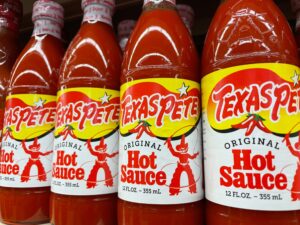Don’t Mess With Texas: One Californian’s Confusion About Hot Sauce
Have you purchased tickets for a Tennessee Williams play—assuming that you were going to enjoy a distinctly “Tennessee” theater experience—only to learn that Tennessee Williams was born in Mississippi? Were you crestfallen to find out that your Canadian bacon didn’t come from Canada at all? If so, you may have a claim for money damages—at least in the Central District of California.
A California consumer named Phillip White recently paid three dollars for a bottle of Texas Pete hot sauce. Relying on the “Texas” name and related branding, Mr. White assumed that he would have a “distinctly ‘Texas’” hot-sauce experience. He didn’t. Mr. White was dismayed to learn something that everyone here in North Carolina already knows: Texas Pete is, and always has been, made by T.W. Garner Food Co. in Winston-Salem.
Mr. White sued T.W. Garner in a California federal court, bringing claims under California’s Unfair Competition Law (an analog to North Carolina’s section 75-1.1), False Advertising Law, and Consumers Legal Remedies Act—as well as claims for breach of warranty and unjust enrichment. Mr. White claimed that he paid “significantly more” than he would have had he known the truth about the hot sauce’s origins.
When T.W. Garner moved to dismiss the claims, the court sided with Mr. White. White v. T.W. Garner provides some lessons about the potential for consumer confusion about product origin.
Howdy: Meet the “Reasonable Consumer”
Each of Mr. White’s statutory claims turned on a “reasonable consumer” test. The Court noted that this test usually presents a fact question that is inappropriate for disposition on a pleadings-stage motion.
To state a claim, Mr. White needed to plead facts to support more than a “mere possibility” that a few isolated consumers could have been misled by the label. Mr. White needed to show a “probability” that “a significant portion of the general consuming public or of targeted consumers, acting reasonably in the circumstances, could be misled.”
To animate this test, the Court identified three “key themes” that apply in food-labeling cases like Mr. White’s:
First, literal truth can, but does not always, protect a manufacturer from a misleading claim.
Second, “qualifiers” in packaging on the back of a label or in an ingredient list “can ameliorate any tendency of the label to mislead,” but will not defeat a claim if they conflict with the “front label claim.”
Finally, descriptive brand names alone can be misleading if they require “little thought” from the consumer who “won’t have the time or interest” to read about the product on a website or the back label.
The Court also explained that Rule 9(b)’s “heightened pleading standard” applied. To survive a motion to dismiss, Mr. White’s claims would need to identify the “who, what, when, where, [] how . . . and why it is false” of the alleged misrepresentation.
A Showdown: Dueling Portrayals of the “Reasonable Consumer”
Mr. White argued that Texas Pete’s label could mislead the “reasonable consumer” into believing that the product originated in Texas. In support of this argument, Mr. White pointed to several characteristics of the label, including “the presence of ‘a white lone star’ reminiscent of the star on the Texas State flag, the cartoon image of a cowboy throwing a lasso, and the brand name ‘Texas Pete.’”
T.W. Garner disagreed, noting that nothing on the Texas Pete packaging or labeling made any misrepresentation about the product’s origin. To the contrary, the back of the label clearly indicated that the product was a “product of the U.S.A.,” manufactured by a company in North Carolina.
T.W. Garner also argued that that, even as a geographic reference, the word “Texas” could refer just as easily to the coastal town of Texas, North Carolina, as to the State of Texas. (T.W. Garner could have similarly argued that the North Carolina State flag, like the Texas State flag, also features a lone white star, albeit less famous than the “Lone Star,” in roughly the same position.)
And as for the name “Texas Pete”? T.W. Garner reasoned that the trademark symbol next to it would lead a consumer to understand “that the Texas Pete brand name is just that—a brand name.”
T.W. Garner cited two cases holding that a complaint about “imagery or language reminiscent of a particular location does not meet the reasonable consumer standard.”
In the first case, Steinberg v. Icelandic Provisions, a New York-based manufacturer of skyr—an “Icelandic cultured dairy product”—labeled its product as “traditional Icelandic Skyr” against the backdrop of a snow-covered countryside. The court rejected a “reasonable consumer” deception theory for multiple reasons. First, it concluded that the “words and imagery do not represent that the [p]roduct is made in Iceland.” It also held that a back-label disclosure of the place of manufacture as “Batavia, NY” would cure any alleged deception. The Ninth Circuit affirmed on this alternative ground, explaining that any front-label ambiguity about origin was “resolved by reference to the back label.”
The second case cited by T.W. Garner, Maeda v. Kennedy Endeavors, rejected a “reasonable consumer” theory about the origins of several Hawaiian-branded snack foods manufactured in Washington state. Maeda considered snack-food labels that used the name “Hawai’i” together with “hula dancers, canoes, beaches, palm trees, and volcanoes.” The Maeda court sided with the manufacturer and rejected the same California statutory claims brought by Mr. White. The court based its decision on the facts that the back label identified Washington state as the place of origin and that the label included no “specific geographic indicia related to Hawaii—such as a map, invitation to visit Defendant on the island, or Hawaiian address or geographic emblem.”
All Hat and No Cowboy: The Court Rejects T.W. Garner’s Arguments
Without citing any authority, the White court reasoned that the name “Texas Pete” on the label makes a claim about the origin of the hot sauce inside:
Looking first to the use of the word “Texas,” it is plausible that a reasonable consumer would assume that the use of the term refers to the state. Indeed, looking at the combination of “Texas” and “Pete,” the phrase, at the very least, indicates that “Texas” modifies “Pete,” with the ultimate result that Pete is from or derives from Texas, and that the hot sauce itself is or derives from Texas.
Conceding that “the imagery of the solo white star and lassoing caricature are not exclusive to the state of Texas,” the White court reasoned that these features nonetheless contributed to the front label’s message. Taken as a whole, the court held that there was a “possibility that a reasonable consumer would believe that the [hot sauces] are based in or originate from Texas.”
The court also rejected T.W. Garner’s argument about the back-label reference to Winston-Salem, North Carolina. It noted that this reference was not an “explicit statement of origin,” but rather a designation of T.W. Garner’s corporate address. The Court hinted that the result might have been different had the back label read “manufactured in Winston-Salem, NC” or “Product of Winston-Salem, NC.”
Ultimately, the Court rested on the legal standard for pleadings-stage motions. Only a “rare situation” merits dismissal of a “reasonable consumer” deception claim, it reasoned, and this simply was not such a rare situation.
Not Our First Rodeo: Takeaways from White v. T.W. Garner
This isn’t the first time we’ve written about food-labeling claims. As we’ve explained before and as White illustrates, they can be hard to predict and highly fact-specific. A few lessons from the White case might prevent a Texas-sized Heartache for other food manufacturers:
First, the use of any place or geographic term in a brand name carries some risk that—rightly or wrongly—a product may be perceived as originating from that place.
Second, the use of imagery or symbolism associated with that locale can reinforce any such perception.
Finally, although a back-label “qualifier” can ameliorate any misperception, that qualifier won’t help if it directly contradicts something on the front label or if it does not make an explicit claim about the place of manufacture.
For all of the reasons persuasively argued by T.W. Garner, it is easy to imagine White turning out differently. It is, after all, improbable that a consumer would purchase a bottle of Texas Pete hot sauce with a genuine expectation of having a “distinctly ‘Texas’” hot-sauce experience. And the very fact that a consumer would make this claim should suggest that the consumer is demanding and discerning. This belies the notions that “little thought” was put into the purchase decision or that the consumer lacked the “time or interest” to discover the product’s true origin. For the time being, though, the message to hot-sauce manufacturers outside of the Lone Star State is clear: Don’t Mess With Texas.



